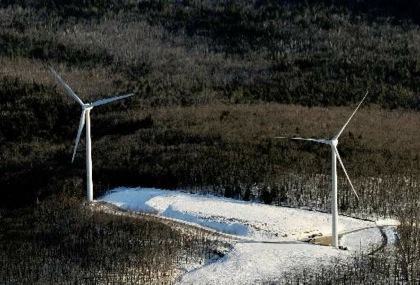 Note: bold by MAMEC
Note: bold by MAMECFriday, September 14, 2012
2 Princeton wind turbines blowing money

Twin 1.5MW wind turbines on the shoulder of Wachusett Mountain in Princeton have been losing money for the local utility. (T&G File Photo/RICK CINCLAIR)
By Sandy Meindersma CORRESPONDENT
PRINCETON — The dual wind turbines that were supposed to save residents of this town money by producing locally generated electricity have actually been losing money, according to a light department official.
Brian Allen, who has been general manager of the Princeton Municipal Light Department since October of last year, reported in a letter to ratepayers that an analysis of the light department's financials reveals that the two turbines, which were installed in 2009, have lost ratepayers $1.875 million since they went online.
Despite the losses, the light department reported a profit of $451,000 in 2011.
The financial losses associated with the turbines are caused by a variety of factors, including a mechanical breakdown of one turbine, greater than projected expenses and lower than expected electricity production.
The turbines were expected to produce 9,000 megawatt hours of electricity each year. Actual production has been closer to 6,500 megawatt hours.
One of the turbines was offline from August 2011 until July of this year, which limited production. Further, while the light department had a three-year warranty on the turbines, disputes between the manufacturer and installation contractor have left PMLD fronting the repair costs and seeking recovery in court.
Because of the costs associated with purchasing, installing and running the turbines, the light department has also not been able to make investments into infrastructure.
The turbines are part of the reason town ratepayers pay some of the highest electricity rates in the state. In 2011, Princeton residents paid an average $173 for 1,000 kilowatts of power; only Unitil ($191) and NStar ($176) charged more.
Mr. Allen said he and the board of light commissioners are looking to see if another utility would be interested in purchasing the power and the associated costs of the turbines.
